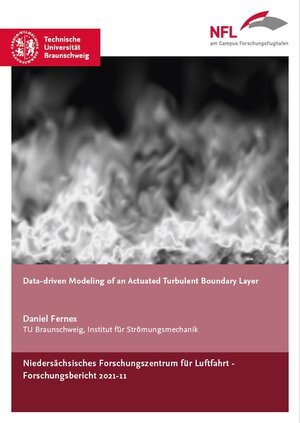Data-driven Modeling of an Actuated Turbulent Boundary Layer
von Daniel FernexAbstract
Active control of the turbulent boundary layer is a promising technique to reduce
the skin friction drag, responsible for about 50% of the overall drag of an aircraft.
The actuation investigated in this work consists in spanwise traveling transversal
surface waves parametrized by the wavelength, the amplitude, and the period. A
maximal drag reduction of 31% is obtained in the tested parameter range. Due
to the numerical cost of the highly resolved simulations, only a sparse coverage of
the parameter space can be achieved, and real-time computations, for applications
such as closed-loop control, are out of reach. This work addresses these limitations
with two novel data-driven algorithms, to 1) predict optimal actuation parameters
and 2) model the unsteady flow response. In the first part, the self-similar response
model (SSM), an empirical and physics-based surrogate method, is employed to
model the drag reduction as function of the actuation parameters using a set of
71 large eddy simulations (LESs). In SSM, extrapolation beyond the training
parameter range is enabled by two key components, namely the parametrized
ridgeline, which indicates the evolution of the optimal response, and a self-similar
behavior identified in the interpolation regime. The SSM results highlight the
critical importance of the wavelength on the optimal drag reduction, and reveal
a constant optimal period, even for varying wavelengths and amplitudes. The
extrapolation accuracy for wavelengths 67% beyond the maximal training value is
validated by two additional LESs, with low relative errors of 2:1% and 0:7%. In
the second part, the unsteady flow dynamics are modeled with the cluster-based
network modeling (CNM) algorithm. CNM reproduces the dynamics on a directed
network, with nodes identified as coarse-grained states of the systems. The motion
between the nodes is characterized by the transition times and probabilities,
inferred from the data with high-order Markov chains. The model resolution is
simply and reliably controlled with adaptive coarse-graining. CNM accurately
reproduces the main dynamics of the actuated boundary layer, validated with the
autocorrelation function and cluster probability distributions. The global stability
of the method allows robust long-term predictions. Boundary layer quantities,
such as the mean streamwise velocity profiles, the skin friction coefficient and
Reynolds stresses are faithfully modeled. The modeled velocity field respects the
mass conservation. A simple control-oriented formulation of CNM allows the
dynamics prediction for new actuation settings beyond the training data.
Active control of the turbulent boundary layer is a promising technique to reduce
the skin friction drag, responsible for about 50% of the overall drag of an aircraft.
The actuation investigated in this work consists in spanwise traveling transversal
surface waves parametrized by the wavelength, the amplitude, and the period. A
maximal drag reduction of 31% is obtained in the tested parameter range. Due
to the numerical cost of the highly resolved simulations, only a sparse coverage of
the parameter space can be achieved, and real-time computations, for applications
such as closed-loop control, are out of reach. This work addresses these limitations
with two novel data-driven algorithms, to 1) predict optimal actuation parameters
and 2) model the unsteady flow response. In the first part, the self-similar response
model (SSM), an empirical and physics-based surrogate method, is employed to
model the drag reduction as function of the actuation parameters using a set of
71 large eddy simulations (LESs). In SSM, extrapolation beyond the training
parameter range is enabled by two key components, namely the parametrized
ridgeline, which indicates the evolution of the optimal response, and a self-similar
behavior identified in the interpolation regime. The SSM results highlight the
critical importance of the wavelength on the optimal drag reduction, and reveal
a constant optimal period, even for varying wavelengths and amplitudes. The
extrapolation accuracy for wavelengths 67% beyond the maximal training value is
validated by two additional LESs, with low relative errors of 2:1% and 0:7%. In
the second part, the unsteady flow dynamics are modeled with the cluster-based
network modeling (CNM) algorithm. CNM reproduces the dynamics on a directed
network, with nodes identified as coarse-grained states of the systems. The motion
between the nodes is characterized by the transition times and probabilities,
inferred from the data with high-order Markov chains. The model resolution is
simply and reliably controlled with adaptive coarse-graining. CNM accurately
reproduces the main dynamics of the actuated boundary layer, validated with the
autocorrelation function and cluster probability distributions. The global stability
of the method allows robust long-term predictions. Boundary layer quantities,
such as the mean streamwise velocity profiles, the skin friction coefficient and
Reynolds stresses are faithfully modeled. The modeled velocity field respects the
mass conservation. A simple control-oriented formulation of CNM allows the
dynamics prediction for new actuation settings beyond the training data.






